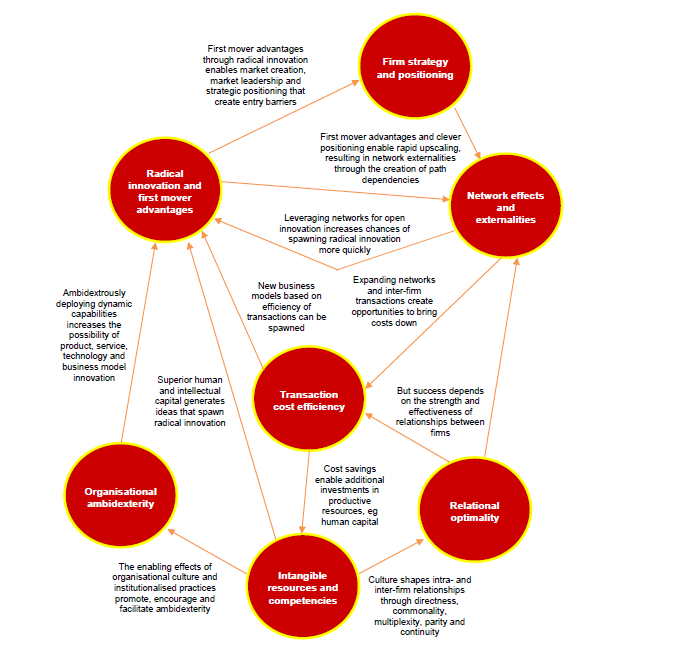In my previous post I have stressed why an integrative approach to sustainable innovation management seems increasingly important to me. The main reason is, that modern organizations range in an environment of various tensions and continuous complexity. This situation requires structures, strategies and cultures to be in place that support dynamic balancing of opposing and complementary elements in the innovation process.
Recently, the Big Innovation Centre has published a very interesting report by Brigitte Andersen and David Wong, titled “The New Normal – Competitive advantage in the digital economy“. It’s an insightful resource, confirming that strategy and innovation frameworks need to be changing due to ongoing advances in ICT/Internet and the resulting complexity and interdependencies. This new digital economy basically affects all firms that conduct some of their business electronically or have adopted some form of digitization – which is almost every organization!
I definitely recommend reading the entire report and will highlight the most important points (mainly taken from the report’s executive summary) only:
Intangibility as source of value
The real sources of value creation and competitive advantage in the digital economy lie in fluid and constantly evolving intangibles such as
- firm strategy and positioning
- radical innovation and first mover advantages
- intangible resources and competencies
- organizational ambidexterity
- network effects and externalities
- transaction cost efficiency
- relational optimality
Each of these intangibles is addressed in detail in the report. These are the dynamic ‘factors’ of the digital economy, and must be harnessed in addition to the conventional factors of production if firms seek to not just survive but also thrive in the new normal. Firms can no longer compete simply on familiar, tangible sources, such as greater access to and efficiency of traditional factors of production (e.g. raw material or capital).
Complementarity and interconnectedness
These seven intangible sources of competitive advantage are in effect interconnected and complementary (see example below). The manifest value of these can be found in their complementarities, and sustainable competitiveness in the synergistic effects obtained from harnessing these sources collectively. It is about strategically combining several or all of these intangibles to create new value and drive business model innovation. This implies that smart configurations of these sources in ways appropriate to the firm’s industry and line of business are capable of helping the firm gain and sustain competitive advantage.
Source: The New Normal – Competitive advantage in the digital economy (authored by Brigitte Andersen and David Wong)
Ecosystem paradigm
The complementarities of these intangible sources demand a new approach to strategy. Business leaders and executives must adopt an ‘ecosystem paradigm’ of competitive advantage in formulating business strategy and reinventing business models. This refers to the need to take a holistic view of all seven intangible sources and consider how, as intricately-linked components of an ecosystem, they might combine to strategically complement each other. As this paradigm represents a departure from conventional thinking, it is capable of helping firms differentiate themselves from competitors and sharpen their competitive edge.
Business model reinvention
However, the path to competitiveness in the digital economy remains treacherous. The various possible configurations of these seven intangible sources also imply that complementarities can emerge in different forms and ways. Just as there is no silver
bullet or a single highway to success, many are the paths to failure and oblivion. This necessitates, to a lesser or greater extent, the reinvention of business models at some point in the evolution of the markets where a firm competes. As market dynamics change, firms must either reactively ensure their business models are at least capable of keeping up or proactively innovate their business models to create new markets altogether.
Takeaway
Given the complementarities and interdependencies of new sources of value, a holistic approach to strategy and innovation is required for almost all firms. The complexity and interlinked nature of these sources contributes to increasingly limited lifespans for competitive advantages. Therefore, competing in the new normal makes it mandatory to continuously (re-)invent strategies and business models that factor in these complex conditions.

2 Responses to An Integrative Approach to Strategy and Innovation